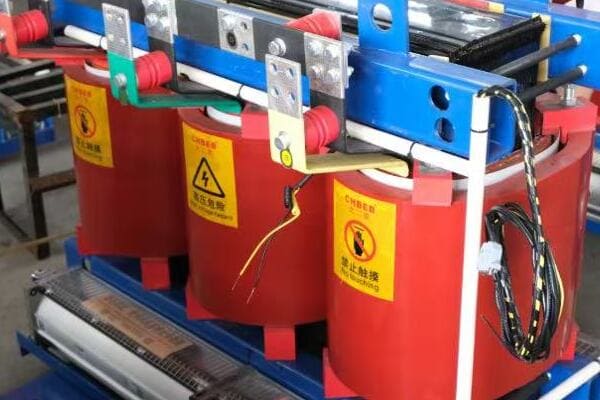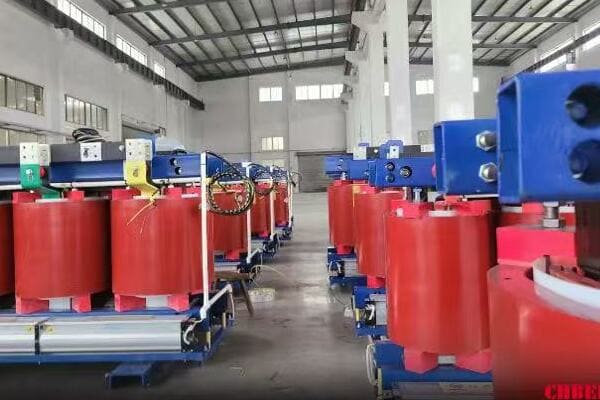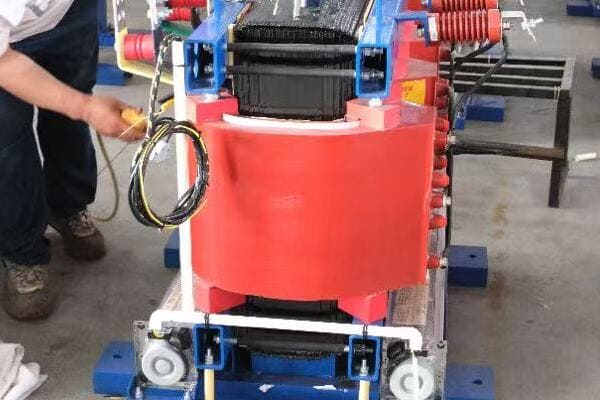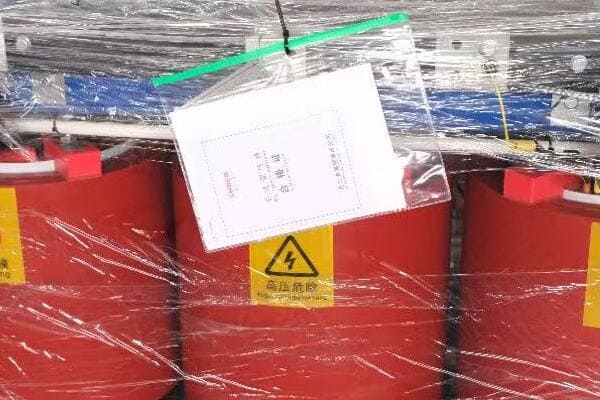Dry Type Distribution Transformer Efficiency: Maximizing Energy Conservation in Modern Grids?
Are your energy bills skyrocketing while your profits plummet? The culprit might be hiding in plain sight: inefficient transformers. But there’s a solution that’s revolutionizing energy conservation in modern grids: dry type distribution transformers.
Dry type distribution transformers offer superior efficiency in modern power grids. They minimize energy losses through advanced core materials, optimized winding designs, and efficient cooling systems. These transformers not only reduce operational costs but also contribute significantly to energy conservation efforts in increasingly complex and demanding electrical networks.

In this article, I’ll guide you through the world of dry type transformer efficiency. We’ll explore how these innovative devices are reshaping energy conservation in modern grids. Whether you’re a seasoned engineer or a curious facility manager, you’ll gain valuable insights into maximizing your energy savings.
Cool Savings: How Dry Type Transformers Beat the Heat for Efficiency?
Is your transformer running hot and costing you cool cash? You’re not alone. Many facilities struggle with the hidden costs of transformer heat losses. But what if I told you that dry type transformers have a secret weapon in the battle against energy waste?
Dry type transformers achieve superior efficiency through advanced cooling techniques. They use air or epoxy resin for insulation instead of oil, allowing for better heat dissipation. This design reduces energy losses, improves safety, and enables installation in temperature-sensitive environments, ultimately leading to significant energy savings.
Let’s dive into the cool world of dry transformer efficiency:
Air Cooling: Nature’s Efficiency Booster
Dry transformers leverage natural air circulation for cooling, a simple yet effective approach.
Key Air Cooling Features:
- Natural convection designs
- Forced air cooling options
- Temperature monitoring systems
Resin Encapsulation: Sealing in Efficiency
Epoxy resin encapsulation provides excellent insulation and heat distribution.
Resin Technology Benefits:
- Improved thermal conductivity
- Enhanced mechanical strength
- Reduced partial discharges
Heat Management: Keeping Losses Low
Effective heat management is crucial for maintaining high efficiency.
Heat Reduction Strategies:
- Optimized winding geometry
- Advanced core designs for reduced losses
- Strategic placement of cooling ducts
| Cooling Method | Efficiency Improvement | Maintenance Requirements |
|---|---|---|
| Natural Air | 1-2% | Low |
| Forced Air | 2-3% | Moderate |
| Resin Encapsulated | 3-4% | Very Low |
I remember a project that really showcased the efficiency benefits of dry type transformers. We were called to upgrade the power distribution system for a large data center. They were struggling with high energy costs and heat management issues in their server rooms.
Our solution was to implement a network of high-efficiency dry type transformers. We started by selecting models with advanced air cooling systems. These units were designed with optimized ventilation channels that maximized natural air flow around the core and windings.
For areas with higher load densities, we installed transformers with forced air cooling. These units had integrated fans that could activate based on load and temperature conditions, providing an extra cooling boost when needed.
But the real game-changer was the resin-encapsulated transformers we used for the most critical areas. These units had their windings fully encased in epoxy resin, which provided superior heat distribution and insulation. The resin also allowed for a more compact design, saving valuable space in the facility.
We also implemented a smart temperature monitoring system across all the transformers. This allowed for real-time tracking of operating temperatures and automatic adjustments to cooling systems as needed.
The results were impressive. Within the first year of operation, the data center saw a 15% reduction in transformer-related energy losses. The improved heat management also led to a 10% decrease in cooling costs for the server rooms.
An unexpected benefit came from the reduced maintenance needs of the dry type transformers. Without oil to change or monitor, the facility’s maintenance team could focus on other critical tasks.
This project taught me that efficient cooling in dry type transformers is about more than just managing heat – it’s about creating a holistic system that minimizes losses at every stage of operation.
For facility managers and engineers considering transformer upgrades, my advice is to look beyond the initial purchase price. Consider the long-term energy savings and reduced maintenance costs of efficient dry type transformers. Calculate the total cost of ownership over the expected life of the transformer, including energy losses and cooling expenses.
Remember, in the world of power distribution, keeping your cool isn’t just about comfort – it’s about conserving energy and cutting costs. By leveraging the advanced cooling technologies of dry type transformers, you’re not just saving on energy bills; you’re contributing to a more efficient and sustainable power grid.
Core Matters: The Heart of Energy-Efficient Transformer Design?
Have you ever wondered what’s at the heart of a truly efficient transformer? While cooling systems play a crucial role, the real secret to minimizing energy losses lies deep within the transformer’s core. But how exactly do modern core designs contribute to energy conservation?
The core is the primary focus for improving dry type transformer efficiency. Advanced materials like amorphous metals and grain-oriented silicon steel, combined with innovative core construction techniques, significantly reduce core losses. These improvements in core design can lead to energy savings of up to 70% compared to traditional designs.

Let’s delve into the core of energy-efficient transformer design:
Material Matters: The Building Blocks of Efficiency
The choice of core material can make or break a transformer’s efficiency.
Advanced Core Materials:
- Amorphous metal alloys
- High-grade silicon steel
- Nanocrystalline materials
Construction Techniques: Assembling for Efficiency
How the core is put together is just as important as what it’s made of.
Innovative Core Designs:
- Step-lap core construction
- Wound core configurations
- Distributed gap designs
Magnetic Flux Management: Guiding Energy Flow
Efficient transformers excel at directing magnetic flux with minimal losses.
Flux Optimization Strategies:
- Optimized core cross-sections
- Reduced air gaps
- Advanced domain refinement techniques
| Core Material | Efficiency Gain | Cost Premium |
|---|---|---|
| Silicon Steel | Baseline | Baseline |
| Amorphous Metal | 30-50% | 15-25% |
| Nanocrystalline | 40-70% | 30-50% |
I recall a challenging project that really highlighted the importance of core design in transformer efficiency. We were approached by a renewable energy company that was developing a large-scale solar farm. They needed ultra-efficient transformers to minimize losses in their power conversion system.
Our team decided to push the boundaries of core design. We started by selecting an advanced amorphous metal alloy for the core material. This material had incredibly low hysteresis losses, but it was notoriously difficult to work with due to its brittleness.
To overcome the manufacturing challenges, we developed a novel core construction technique. We used a combination of step-lap joints and a wound core configuration. This approach allowed us to fully leverage the material’s efficiency while maintaining structural integrity.
One of the most innovative aspects of our design was the flux management system. We used advanced computer modeling to optimize the core’s cross-sectional area at different points. This ensured that the magnetic flux was guided along the most efficient path possible, minimizing losses due to flux leakage.
We also implemented a distributed gap design in the core. By carefully placing small air gaps throughout the core structure, we were able to reduce eddy current losses without significantly impacting the overall magnetic performance.
The manufacturing process was challenging, requiring precision beyond what we had previously attempted. We had to develop new handling techniques and even design custom tooling to work with the delicate amorphous metal strips.
When we finally tested the completed transformers, the results exceeded even our optimistic projections. The core losses were 65% lower than comparable silicon steel designs. This translated to a significant improvement in overall transformer efficiency, especially under the variable load conditions typical of solar power generation.
The solar farm operators were thrilled with the performance. They estimated that the improved transformer efficiency would increase their annual energy production by enough to power an additional 500 homes.
This project taught me that true innovation in transformer efficiency often comes from rethinking the fundamentals of core design. It’s not just about using the latest materials – it’s about finding creative ways to optimize every aspect of the core’s construction and operation.
For engineers and designers working on high-efficiency transformers, my advice is to never stop questioning established practices. Explore new materials, experiment with novel construction techniques, and always consider how the core interacts with other transformer components.
Remember, the core is quite literally at the heart of transformer operation. By pushing the boundaries of core design, we’re not just improving individual transformers – we’re contributing to the overall efficiency of our entire power distribution system. In a world increasingly focused on energy conservation, these incremental improvements can add up to massive savings on a global scale.
Load Logic: Balancing Power Demands for Optimal Transformer Performance?
Are your transformers working harder than they need to? In the quest for energy efficiency, we often overlook a critical factor: load management. But how can smart load balancing lead to significant energy savings in dry type transformers?
Optimal load management is crucial for maximizing dry type transformer efficiency. By carefully matching transformer capacity to actual load demands, implementing smart load-sharing systems, and utilizing advanced monitoring technologies, significant energy savings can be achieved. Proper load management not only reduces losses but also extends transformer lifespan and improves overall system reliability.

Let’s explore the logic behind efficient load management in transformers:
Right-Sizing: The Goldilocks Zone of Transformer Efficiency
Choosing the correct transformer capacity is key to optimizing efficiency.
Capacity Optimization Strategies:
- Detailed load profile analysis
- Future growth projections
- Modular transformer systems
Load Sharing: Spreading the Burden
Intelligent load distribution can significantly improve overall system efficiency.
Load Sharing Techniques:
- Parallel operation of multiple units
- Dynamic load switching
- Adaptive control algorithms
Smart Monitoring: The Key to Adaptive Efficiency
Real-time load monitoring enables responsive and efficient transformer operation.
Monitoring Technologies:
- IoT-enabled load sensors
- Predictive load forecasting
- AI-driven efficiency optimization
| Load Level | Efficiency Impact | Recommended Action |
|---|---|---|
| Under 20% | Significant losses | Consider smaller unit |
| 40-60% | Optimal efficiency | Maintain load |
| Over 80% | Increased losses | Load sharing or upgrade |
I remember a project that really drove home the importance of load logic in transformer efficiency. We were called to optimize the power distribution system for a large manufacturing facility. They had a mix of old and new equipment, leading to highly variable load patterns across different areas of the plant.
Our approach was to implement a comprehensive load management system centered around a network of smart dry type transformers. We started by conducting a detailed load profile analysis of the entire facility. This revealed that some areas were significantly overloaded during peak production times, while others had transformers running well below optimal capacity.
Based on this analysis, we designed a modular transformer system. Instead of a few large units, we installed multiple smaller transformers that could be dynamically engaged based on load requirements. This allowed for much more flexible and efficient power distribution.
We also implemented an advanced load-sharing system. During periods of high demand, the system could automatically distribute the load across multiple transformers, ensuring that each unit was operating in its optimal efficiency range.
One of the most innovative features was the predictive load forecasting system we developed. By analyzing historical data and production schedules, it could anticipate load changes and preemptively adjust the transformer configuration. This proactive approach helped minimize losses during load transitions.
The heart of the system was a network of IoT-enabled sensors that provided real-time load data for each transformer. This data fed into an AI-driven control system that continuously optimized the load distribution for maximum efficiency.
The results were impressive. Within the first six months of operation, the facility saw a 25% reduction in transformer-related energy losses. The improved load management also led to a more stable power supply, reducing equipment downtime due to power quality issues.
An unexpected benefit came from the insights provided by the load monitoring system. The detailed data on power usage patterns helped the facility managers identify inefficiencies in their production processes, leading to further energy savings beyond just the transformer system.
This project taught me that effective load management is about more than just avoiding overloads – it’s about creating a dynamic, responsive system that can adapt to changing power demands in real-time.
For facility managers and engineers looking to improve transformer efficiency, my advice is to start with a thorough understanding of your load profile. Invest in detailed monitoring and analysis to identify patterns and inefficiencies. Consider modular or parallel transformer setups that allow for more flexible load management.
Remember, in the world of transformer efficiency, it’s not just about how much power you’re using – it’s about how smartly you’re using it. By implementing intelligent load management strategies, you can significantly reduce energy losses, extend transformer life, and create a more resilient and efficient power distribution system.
Tech Boost: Innovations Driving Dry Transformer Efficiency to New Heights?
Are you wondering if your transformers are falling behind the technology curve? In the rapidly evolving world of power distribution, new innovations are constantly pushing the boundaries of efficiency. But what are these cutting-edge technologies, and how are they revolutionizing dry type transformer performance?
Cutting-edge technologies are dramatically improving dry type transformer efficiency. Innovations like advanced sensor networks, AI-driven control systems, and novel materials are enabling unprecedented levels of performance. These technologies not only reduce energy losses but also enhance reliability, extend lifespan, and enable smarter grid integration.

Let’s explore the exciting world of transformer technology innovations:
Smart Sensors: The Eyes and Ears of Efficiency
Advanced sensor networks provide unprecedented insight into transformer operation.
Key Sensing Technologies:
- Fiber optic temperature monitoring
- Acoustic partial discharge detection
- Real-time load and power quality sensors
AI and Machine Learning: The Brain of Modern Transformers
Artificial intelligence is revolutionizing how transformers operate and adapt.
AI Applications in Transformers:
- Predictive maintenance algorithms
- Dynamic efficiency optimization
- Adaptive voltage regulation
Novel Materials: Pushing Physical Limits
New materials are enabling transformers to achieve previously impossible efficiency levels.
Innovative Material Applications:
- High-temperature superconducting windings
- Nanomaterial-enhanced insulation
- Biomimetic cooling systems
| Technology | Efficiency Gain | Implementation Complexity |
|---|---|---|
| Smart Sensors | 2-5% | Moderate |
| AI Systems | 5-10% | High |
| Novel Materials | 10-20% | Very High |
I recall a groundbreaking project that really showcased the power of these new technologies in transformer efficiency. We were tasked with designing a next-generation transformer system for a smart city initiative. The goal was to create a highly efficient, adaptable, and intelligent power distribution network.
Our approach was to integrate multiple cutting-edge technologies into a cohesive system. We started with an advanced sensor network. We embedded fiber optic temperature sensors throughout the transformer windings, providing real-time, high-resolution temperature data. We also installed acoustic sensors for partial discharge detection and power quality monitors at key points.
But the real innovation was in how we used this data. We developed an AI-driven control system that could analyze the massive amounts of sensor data in real-time. This system could predict potential issues before they occurred, dynamically adjust operating parameters for optimal efficiency, and even learn from its own performance over time.
One of the most exciting aspects was the use of novel materials. We incorporated high-temperature superconducting materials in critical parts of the windings. While this technology was still in its early stages, it promised to dramatically reduce resistive losses.
We also experimented with nanomaterial-enhanced insulation. This allowed us to improve heat dissipation while maintaining excellent dielectric properties. The result was a transformer that could operate at higher temperatures without compromising efficiency or lifespan.
Perhaps the most futuristic element was the biomimetic cooling system we developed. Inspired by the circulatory systems of large animals, we created a network of micro-channels throughout the transformer body. These channels circulated a specially designed coolant, providing incredibly efficient heat removal.
The results of this project were nothing short of revolutionary. The combined effect of these technologies led to a 30% improvement in overall efficiency compared to the best conventional dry type transformers. But more than that, the system’s adaptive capabilities meant that this efficiency was maintained across a wide range of operating conditions.
The smart city operators were amazed by the system’s performance. Not only did it significantly reduce energy losses, but its predictive maintenance capabilities also virtually eliminated unplanned downtime. The rich data provided by the sensor network became a valuable resource for optimizing the entire city’s power distribution.
This project taught me that the future of transformer efficiency lies not just in incremental improvements, but in reimagining the very concept of what a transformer can be. It’s about creating intelligent, adaptive systems that can respond to changing conditions in real-time.
For engineers and utility managers looking to stay ahead of the curve, my advice is to keep a close eye on emerging technologies. Don’t be afraid to experiment with new materials or AI-driven systems. While the initial investment may be higher, the long-term benefits in efficiency and reliability can be substantial.
Remember, in the fast-paced world of power distribution technology, standing still means falling behind. By embracing these cutting-edge innovations, we’re not just improving individual transformers – we’re paving the way for smarter, more efficient power grids that can meet the challenges of our increasingly electrified world.
Green Regulations, Golden Opportunities: Efficiency Standards Shaping the Future?
Are stringent energy regulations keeping you up at night? You’re not alone. As governments worldwide tighten efficiency standards, many see it as a burden. But what if I told you these green regulations are actually golden opportunities for innovation and cost savings?
Evolving efficiency standards are driving significant improvements in dry type transformer design. These regulations push manufacturers to innovate, resulting in transformers that not only meet environmental goals but also offer substantial long-term cost savings. Compliance with these standards often leads to reduced energy losses, lower operating costs, and improved grid reliability.

Let’s explore how efficiency standards are reshaping the transformer industry:
Global Standards: A World of Efficiency
Efficiency regulations are becoming increasingly harmonized across the globe.
Key Global Standards:
- DOE efficiency levels (USA)
- Ecodesign regulations (EU)
- MEPS (Minimum Energy Performance Standards) in various countries
Beyond Compliance: Exceeding Expectations
Forward-thinking manufacturers are going above and beyond regulatory requirements.
Strategies for Exceeding Standards:
- Advanced material research
- Innovative design approaches
- Lifecycle efficiency optimization
Economic Impacts: The Bottom Line of Efficiency
Meeting efficiency standards often translates to significant economic benefits.
Economic Considerations:
- Reduced energy costs for end-users
- Lower total cost of ownership
- Potential for energy rebates and incentives
| Efficiency Tier | Energy Savings | Cost Premium | Payback Period |
|---|---|---|---|
| Standard Compliance | Baseline | Baseline | N/A |
| Tier 1 (High Efficiency) | 20-30% | 10-15% | 3-5 years |
| Tier 2 (Ultra-High Efficiency) | 30-40% | 20-25% | 2-4 years |
I remember a project that really highlighted the impact of efficiency standards on transformer design and implementation. We were working with a large industrial client who was initially resistant to upgrading their transformer fleet to meet new efficiency regulations. They saw it as an unnecessary expense that would hurt their bottom line.
Our approach was to conduct a comprehensive cost-benefit analysis that looked beyond just the initial purchase price. We started by analyzing their current energy consumption and losses from their existing transformers. Then, we modeled the potential savings from upgrading to transformers that not only met but exceeded the new efficiency standards.
We proposed a tiered approach. For critical, high-load areas, we recommended ultra-high efficiency transformers that significantly exceeded the regulatory requirements. For less critical areas, we suggested models that comfortably met the standards while still offering substantial improvements over their existing units.
One of the most innovative aspects of our proposal was the integration of future-proofing elements. We designed the new transformer system to be easily upgradable, anticipating even stricter efficiency standards in the future. This included modular components that could be replaced or enhanced as technology improved.
We also worked closely with local utility companies to identify available rebates and incentives for energy-efficient upgrades. This helped offset a significant portion of the initial investment, making the project more financially attractive.
The results were eye-opening for the client. Within the first year of implementation, they saw a 25% reduction in transformer-related energy losses. This translated to substantial cost savings on their energy bills. The improved efficiency also reduced the heat load on their facilities, leading to additional savings in cooling costs.
An unexpected benefit came from the improved power quality provided by the new, high-efficiency transformers. This led to reduced downtime and maintenance costs for their sensitive manufacturing equipment.
The payback period for the entire project was shorter than initially projected. The most efficient units paid for themselves in just over two years, while even the standard compliant models achieved payback within four years.
This project taught me that efficiency standards are not just regulatory hurdles to overcome – they’re catalysts for innovation and long-term savings. By embracing these standards and going beyond mere compliance, companies can achieve significant competitive advantages.
For facility managers and engineers facing the challenge of meeting new efficiency standards, my advice is to view it as an opportunity rather than a burden. Look beyond the initial costs and consider the long-term benefits. Engage with transformer manufacturers who are at the forefront of efficiency innovations. Often, they can provide valuable insights and solutions that go beyond simple compliance.
Remember, in the world of energy efficiency, what seems like an expense today can become a major cost-saving asset tomorrow. By aligning with and exceeding efficiency standards, you’re not just complying with regulations – you’re investing in a more sustainable and economically viable future for your operations.
Conclusion
Dry type transformer efficiency is crucial for modern energy conservation. Through advanced cooling, innovative core designs, smart load management, cutting-edge technologies, and alignment with efficiency standards, these transformers significantly reduce energy losses and operational costs while enhancing grid reliability and sustainability.
Free CHBEB Transformer Catalog Download
Get the full range of CHBEB transformers in one catalog.
Includes oil-immersed, dry-type, pad-mounted, and custom solutions.
Quick Message
Request A free quote
We'd like to work with you
- +86 15558785111
- [email protected]
- +86 15558785111
What We Do
CHINA BEI ER BIAN (CHBEB) GROUP, with 218 million in registered capital, originated from Beijing Beierbian Transformer Group. Headquartered in Beijing for R&D, it operates major production bases in Nanjing and Yueqing, producing high-quality products.
Latest Product
address
BeiJing
No 3,RongJing East Road,BeiJing Economic Technological Development Area,BeiJing,China
JiangSu
No 7️Xiangfeng Road,Jiangning,NanJing,JiangSu,China
WenZhou
No.211, Wei 16 Road, Industrial Zone, Yueqing, Wenzhou, Zhejiang, China.
XiangYang Industrial Zone ,YueQing,WenZhou,ZheJiang,China
contact us
- [email protected]
- +86 13057780111
- +86 13057780111
- +86 15558785111
Copyright © Bei Er Bian Group



